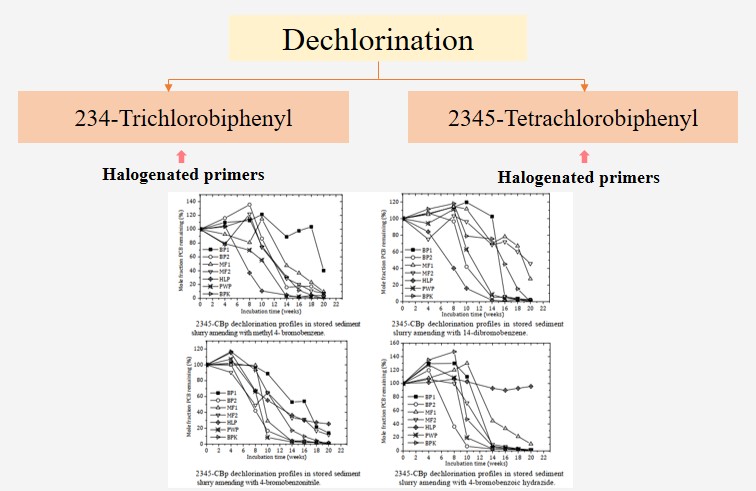Dechlorination of 234-Trichlorobiphenyl and 2345-Tetrachlorobiphenyl by using halogenated primers
DOI:
https://doi.org/10.55674/snrujst.v14i1.244583Keywords:
Sediment Slurries (SS), Polychlorinated Biphenyls (PCBs), Dechlorination, Halogenated PrimingAbstract
The research aimed to investigate the sustainability of the dechlorination ability of the microbes after long-term cold storage. Polychlorinated biphenyls (PCBs) dechlorinating bacteria were activated and characterised
by priming congeners. Sediment slurries (SS) were collected from several streams around the Samut Prakan Province in Thailand. While dechlorination of 234-CBp was persistent, 2345-CBp dechlorination was relatively more active. Halogenated priming congeners, including methyl 4-bromobenzene, 14-dibromobenzene, 4-bromobenzonitrile, and 4-bromobezoic hydrazide, could significantly stimulate the dechlorination of 234-CBp but not 2345- CBp. The identified PCB dechlorinating groups were Firmicutes and Proteobacteria. Halogenated priming congeners could activate dechlorination in Thailand, where PCBs dechlorinating microbes were abundant.
References
B.C. Gomes, M.A.T. Adorno, D.Y. Okada, T.P. Delforno, P.C.F. Lima Gomes, I.K. Sakamoto, M.B.A. Varesche, Analysis of a microbial community associated with polychlorinated biphenyl degradation in anaerobic batch reactors. Biodegradation. 25 (2014) 797–810.
G.M. Quero, D. Cassin, M. Botter, L. Perini, G.M. Luna, Patterns of benthic bacterial diversity in coastal areas contaminated by heavy metals, polycyclic aromatic hydrocarbons (PAHs) and polychlorinated biphenyls (PCBs). Front. Microbiol. 6 (2015) 1053 - 1068.
D.A. Abramowicz, Aerobic PCB Biodegradation and Anaerobic PCB Dechlorination in the Environment. Environ. Health Perspect. 103 (1994) 97–99.
J. Anotai, J.M. Chyan, W. Sudjarid, W. Wanitchapichat, I.M. Chen, Hexachlorobenzene dechlorination by enriched mixed cultures from Thai canal. Fresenius Environ. Bull. 19 (2010) 469–473.
I.M. Chen, W. Wanitchapichat, T. Jirakittayakorn, S. Sanohniti, W. Sudjarid, C. Wantawin, J. Voranisarakul, J. Anotai, Hexachlorobenzene dechlorination by indigenous sediment microorganisms. J. Hazard. Mater. 177 1-3 (2010) 244–50.
W. Sudjarid, I.M. Chen, W. Monkong, J. Anotai, Reductive dechlorination of 2, 3, 4-chlorobiphenyl by biostimulation and bioaugmentation. Environ. Eng. Sci. 29 (2012) 255–261.
L.F. Nies, T.M. Vogel, Effects of organic substrates on dechlorination of aroclor 1242 in anaerobic sediments. Appl. Environ. Microbiol. 26 (1990) 2612–2617.
V. Krumins, J.W. Park, E.K. Son, L.A. Rodenburg, L.J. Kerkhof, M.M. Haggblom, D.E. Fennell, PCB dechlorination enhancement in Anacostia River sediment microcosms. Water Res. 43 (2009) 4549–4558.
J. Wiegel, Q. Wu, Microbial reductive dehalogenation of polychlorinated biphenyls. FEMS Microbiol. Ecol. 32 (2000) 1–15.
D.L. Bédard, H. Van Dort, K.A. Deweerd, Brominated Biphenyls Prime Extensive Microbial Reductive Dehalogenation of Aroclor 1260 in Housatonic River Sediment. Appl. Environ. Microbiol. 373 (1998) 1786–95.
K.A. DeWeerd, D.L. Bédard, Use of Halogenated Benzoates and Other Halogenated Aromatic Compounds To Stimulate the Microbial Dechlorination of PCBs. Environ. Sci. Technol. 33 (1999) 2057–2063.
G. Muyzer, E.C. de Waal, A.G. Uitterlinden, Profiling of Complex Microbial Populations by Denaturing Gradient Gel Electrophoresis Analysis of Polymerase Chain Reaction-amplified Genes Coding for 16S rRNA. Appl. Environ. Microbiol. 53 (1993) 695–700.
S.F. Altschul, W. Gish, W. Miller, E.W. Myers, D.J. Lipman, Basic local alignment search tool. J. Mol. Biol. 215 (1990) 403 – 410.
G. Tchobanoglous, F.L. Burton, E. Metcalf, Wastewater Engineering: Treatment, Disposal, and Reuse; McGraw-Hill series in water resources and environmental engineering, McGraw-Hill, 1991.
I.M. Chen, F.C. Chang, Y.S. Wang, Correlation of Gas Chromatographic Properties of Chlorobenzenes and Polychlorinated Biphenyls with the Occurrence of Reductive Dechlorination by Untamed Microorganisms. Chemosphere. 45 (2001) 223 – 229.
I.M. Chen, Y.F. Chang, H. Lin, Microbial Dechlorination of Hexachlorobenzene by Untamed Sediment Microorganisms in Taiwan. J. Hazard. Toxic. Radioact. Waste. 406 (2004) 73–78.
N. Yoshida, N. Takahashi, A. Hiraishi, Phylogenetic Characterization of a Polychlorinated-dioxin Dechlorinating Microbial Community by use of Microcosm Studies. Appl. Environ. Microbiol. 71 (2005) 4325–4334.

Downloads
Published
How to Cite
Issue
Section
License
Copyright (c) 2022 SNRU Journal of Science and Technology

This work is licensed under a Creative Commons Attribution-NonCommercial-NoDerivatives 4.0 International License.








